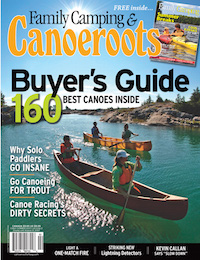Tom and I went on our first canoe trip together last summer. We’d been engaged for a while, but we had never pushed off for a long trip. Both of us are paddlers, so we had nothing short of a lifetime of shared happiness—or misery—on the line.
It took us a while to agree on a plan. He wanted to paddle the Nahanni or race in the Yukon River Quest. I wanted to disappear for a few weeks in Temagami, Kipawa, or Quetico. We settled on a two-week lake trip in Quetico Provincial Park so Tom could at least check off an area he hadn’t been to before. I felt a twinge of alarm when I loaded the paddles in the car; his a gleaming bent-shaft racing paddle, mine a battered old Lolk.
As we pulled away it was like paddling with a machine. Tom hauled gallons of water with each fierce paddle stroke. He pad- dled so fast I had to either cut my sterning stroke to a quick draw or pry or ignore his pace completely. I didn’t know any camp songs fast enough to match his rhythm. I tucked my head down, and dreaded the next 14 days.
On day two Tom kept looking down to check on his GPS and heart rate monitor. Apparently this trip was part of his training for the New York marathon and we weren’t covering the kind of ground he thought we should. His day-two journal entry reads, “Today we paddled hard but we also stopped a lot so, although I measured our top cruising speed at seven kilometres per hour, and we covered 3.5 kilometres in our first 31 minutes, we only covered 22.5 kilometres in eight hours.” I read the entry with horror. Later, he slept while I lay awake for hours. Fretting.
WHITEWATER VS FLATWATER
To Tom, lake trips are only a step above car camping. All those flat, featureless kilometres of lakes bore him. Tom trips to conquer the outdoors. In the morning he’s packed and out of the tent while I’m still horizontal and thinking, “shorts or pants?” On portages he isn’t happy until he’s loaded down like a packhorse and running up the hills.
And, of course, Tom loves rivers. He likes how the adrenaline forces him to be in the moment. Tom says rivers are a metaphor for life: they have a destiny, and they flow by like time.
The way I see it, whitewater wrecks an otherwise perfect canoe trip. I like listening to the wind in the trees. I want to look around. I dread the frantic paddling and shouting of rapids. Rivers and I work at cross purposes. They crank a trip into fast forward, while I want to slow things down.
My defence against Tom’s driven approach varied. Some days I tried to keep up, some days I resorted to sabotage. My methods included: picking fights, sex, cooking blueberry pie, swimming, complaining, getting us lost, sleeping in, searching for my camera and (my favourite) repeatedly turning around when in the bow to talk to him.
A tiny island rising out of the southwest corner of Sarah Lake provided some common ground. I heard the Hallelujah chorus when our canoe touched gravel that afternoon. It was the ulti- mate lake campsite. A small fire pit, swimming rocks in clear water, a pile of beaver-prepped firewood. The sun set upwind and we stayed up late drinking Labrador tea and counting stars.
That night we agreed on a few things. We both like islands with good swimming rocks and we both like to read in the ham- mock. We also sorted out our route. We agreed on fixed goals for him, and included some short days for me. Days four through six were lovely.
Day seven was another matter.
MAKING COMPROMISES
It was late afternoon and we were heading south from Kawnipi into Kahshahpiwi Creek. Tom had the map. I heard a sloshing coming from downstream. We pulled out to take a look. It was a set of rapids about 30 metres long with tall standing waves and a dark tongue of river cutting between sharp black boulders. He said, excitedly, “It’s totally runnable.” I said, “No, it’s dangerous.” He laughed. Then he stopped—quickly. And we walked—quietly.
A few hours later after much crying, shouting, and stubborn defensiveness we agreed to conditions under which I will learn to paddle whitewater. None of them include a loaded, borrowed canoe and the end of the day.
Tom never made an explicit concession to my way of paddling, but after a rest day on day nine I was no longer worried about his appreciation for still water. The island we camped on curved like a horseshoe in the middle Kahshahpiwi Lake. We ate pancakes, wrote letters, fished and dozed in the hammock. Tom wrote seven pages in the journal that night as testimony to his transformation: “I woke up and watched a bald eagle and a heard a loon calling across the lake. I sometimes forget how the routines of trip are charmed by nature: the weather, wildlife, light, fire, stars.”
I never saw his heart rate monitor again.
Tory Bowman, in the spirit of compromise, has consented to taking a course in whitewater canoeing.




